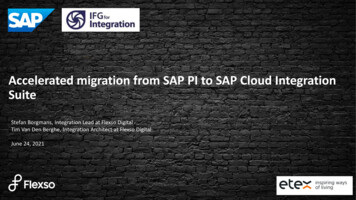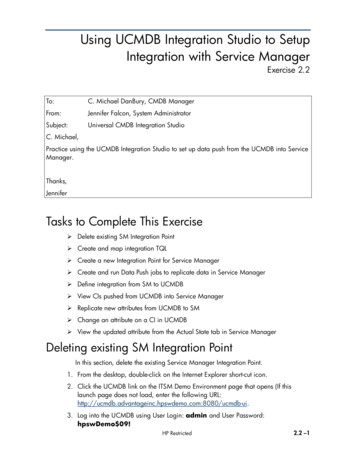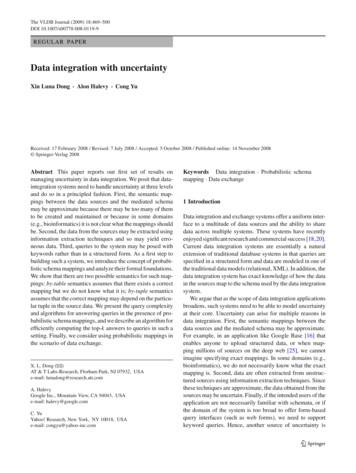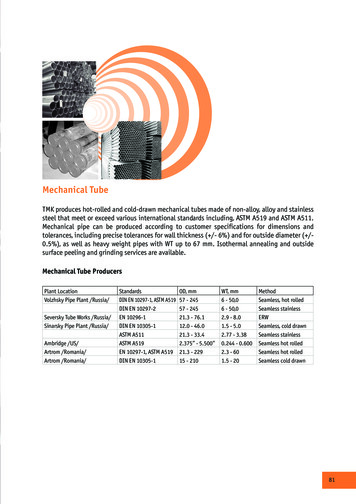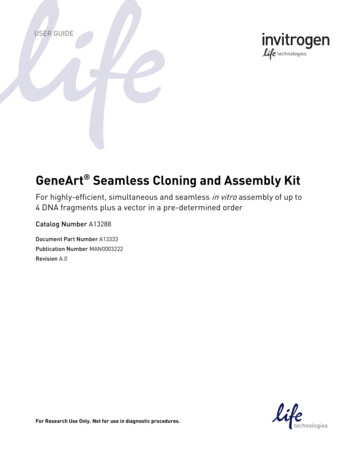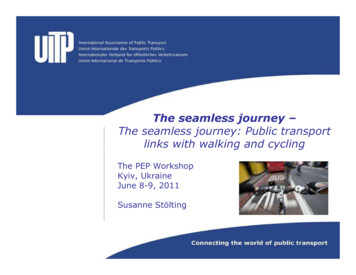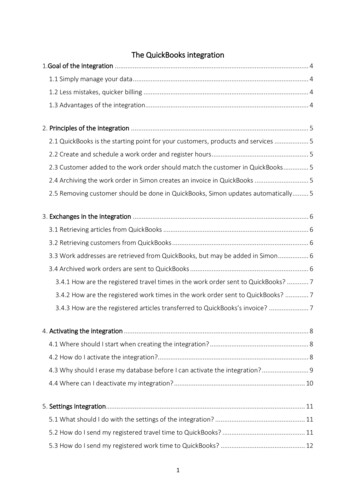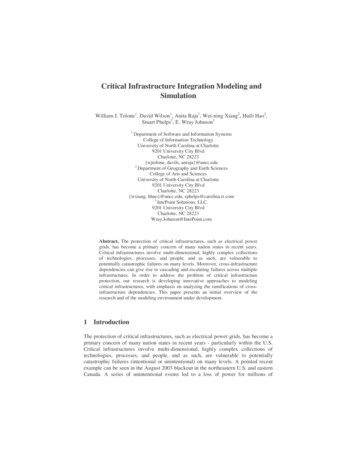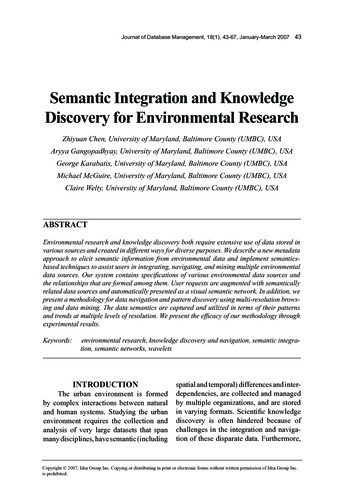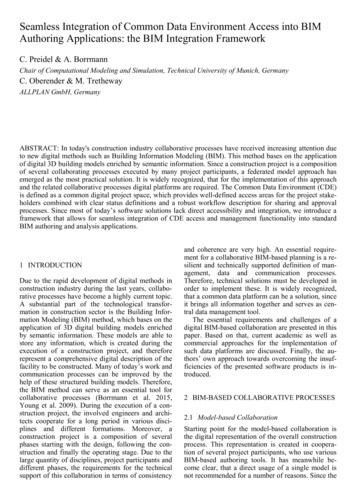
Transcription
Seamless Integration of Common Data Environment Access into BIMAuthoring Applications: the BIM Integration FrameworkC. Preidel & A. BorrmannChair of Computational Modeling and Simulation, Technical University of Munich, GermanyC. Oberender & M. TrethewayALLPLAN GmbH, GermanyABSTRACT: In today's construction industry collaborative processes have received increasing attention dueto new digital methods such as Building Information Modeling (BIM). This method bases on the applicationof digital 3D building models enriched by semantic information. Since a construction project is a compositionof several collaborating processes executed by many project participants, a federated model approach hasemerged as the most practical solution. It is widely recognized, that for the implementation of this approachand the related collaborative processes digital platforms are required. The Common Data Environment (CDE)is defined as a common digital project space, which provides well-defined access areas for the project stakeholders combined with clear status definitions and a robust workflow description for sharing and approvalprocesses. Since most of today’s software solutions lack direct accessibility and integration, we introduce aframework that allows for seamless integration of CDE access and management functionality into standardBIM authoring and analysis applications.1 INTRODUCTIONDue to the rapid development of digital methods inconstruction industry during the last years, collaborative processes have become a highly current topic.A substantial part of the technological transformation in construction sector is the Building Information Modeling (BIM) method, which bases on theapplication of 3D digital building models enrichedby semantic information. These models are able tostore any information, which is created during theexecution of a construction project, and thereforerepresent a comprehensive digital description of thefacility to be constructed. Many of today’s work andcommunication processes can be improved by thehelp of these structured building models. Therefore,the BIM method can serve as an essential tool forcollaborative processes (Borrmann et al. 2015,Young et al. 2009). During the execution of a construction project, the involved engineers and architects cooperate for a long period in various disciplines and different formations. Moreover, aconstruction project is a composition of severalphases starting with the design, following the construction and finally the operating stage. Due to thelarge quantity of disciplines, project participants anddifferent phases, the requirements for the technicalsupport of this collaboration in terms of consistencyand coherence are very high. An essential requirement for a collaborative BIM-based planning is a resilient and technically supported definition of management, data and communication processes.Therefore, technical solutions must be developed inorder to implement these. It is widely recognized,that a common data platform can be a solution, sinceit brings all information together and serves as central data management tool.The essential requirements and challenges of adigital BIM-based collaboration are presented in thispaper. Based on that, current academic as well ascommercial approaches for the implementation ofsuch data platforms are discussed. Finally, the authors’ own approach towards overcoming the insufficiencies of the presented software products is introduced.2 BIM-BASED COLLABORATIVE PROCESSES2.1 Model-based CollaborationStarting point for the model-based collaboration isthe digital representation of the overall constructionprocess. This representation is created in cooperation of several project participants, who use variousBIM-based authoring tools. It has meanwhile become clear, that a direct usage of a single model isnot recommended for a number of reasons. Since the
working areas of different disciplines may overlap ina single model, the responsibilities cannot be assigned clear and unambiguously. Yet another reasonis, that the project stakeholders have usually no interest, to share their intermediate models due toframework conditions such as the contract constellation. Therefore, various guidelines such as the Singapore BIM Guide (BCA Singapore 2013) or theBritish Publicly Available Specification (PAS) 1192(British Standards Institution 2013) implement adomain-specific approach, which means, that modelauthors have full access only to the domain-specificsub-model they responsible for. These subsets describe a certain aspect of the overall model and sothey are usually called discipline or domain-specificpartial model. According to this resulting federatedmodel approach each domain-specific model ismaintained only by an assigned author himself. Inthis way the responsibilities and authorship of building elements as well as changes during the executionof the construction project are managed unambiguously.important safety measure is the quality barrier orgate. A domain-specific model has to pass this gatebefore it can be merged with the coordination model.The quality gate represents specific checking procedures regarding the agreed project standards such asa completeness, clash or suitability check. Depending on the project agreements this first compliancecheck can be a prerequisite for the merge and therefore has to be executed on side of the disciplinemodel author. As shown in Figure 2, shows the development of the domain-specific due to this intermediate steps until it can finally be merged with theother valid data since it complies the project standards by now.Figure 2. Project data development during collaboration in aBIM-based construction project2.2 Common Data EnvironmentFigure 1. BIM Modelling and Collaboration Procedures according to BCA Singapore (2013)To ensure the integrity and consistency of theoverall model, the domain-specific models have tobe compared and checked for inconsistencies or collisions at defined regular intervals. For this purpose,the federated model approach provides a central coordination model (Solihin et al. 2016). This modelstores the validated and agreed merged informationand in turn provides exactly the information, whichis required for the collaboration of at least two disciplines. In this way, the coordination model servesnot only as a starting point, but also as a checkingbase for inconsistencies in single domain-specificmodels. Due to the outstanding importance of thecoordination model, its quality must unconditionallycomply the agreed project standards at any time. Tocatch possible errors as early as possible, a furtherAs discussed in Section 2.1 the management of thedigital information and the related processes is a major task during the BIM-based execution of a construction project. It is widely recognized, that for thestorage and administration of the different modelsand to enable the above-mentioned processes, digitaldata platforms are required. At this point the PAS1192 (British Standards Institution 2013) specifies atechnological foundation, the Common Data Environment (CDE). The CDE basically represents acentral space for collecting, managing, evaluatingand sharing information. All project participants retrieve the data from the CDE and in turn store theirdata here. The CDE stores the coordination model,all domain-specific partial models, data bases anddocuments, which are necessary during the execution of the project. Therefore, it describes the comprehensive BIM-process. The centralization of datastorage within the CDE reduces the jeopardy of dataredundancy and ensures the availability of up-todate data at any time. Furthermore, the CDE leads toa higher rate of reusability of information, simplifiesthe aggregation of model information and simultaneously serves as a central archive for documentation. Since this environment is accessible for all ofthe project participants, it can be used as a platformfor BIM-based collaborative processes. It should be
Figure 3. Layer model of a Common Data Environment, inspired by (British Standards Institution 2013)noted, that the PAS 1192 basically provides recommendations for the technological as well as management-process-based implementation. In thissense, the guideline describes a broad framework fora CDE, but does not set detailed requirements, sothat there is room for interpretations and the technical implementation. This setup of a CDE can depend in a variety of ways effected by the application,project volume and participated parties. Nevertheless, a more detailed implementation of such a CDEshall be presented exemplarily. In general, the architecture of a CDE can be described as a layered structure (see Figure 3). On top of the data keeping, thestructuring of the stored information is an essentialpart of the CDE. This structuring has to be agreed onin the beginning of a project and should be updated– if needed contractual - continuously. Next to theactual storage of the information, different processesand workflows, e.g. for the share of information, reviewing, versioning or archiving should be welldefined. Furthermore, the merging process of various discipline models as described in Section 2.1should be technically defined in here.In this way the CDE fulfills the requirements,which were set in Section 2.1, and the first basic prerequisites for a cooperative processing of the information is enabled.keep the model quality continuously on a high levelare the agreed project standards, which are valid forany piece of information by merging them with thecoordination model at the latest. These standards setlegally binding requirements for the way data isstored. Therefore, the created model information hasto be checked iteratively regarding these standards.To do so, not only well-defined checking processesare required, but also that any participant is aware ofthe quality of his created information. Therefore,each author should know and take care about theagreed project standards and must be able to dealwith the basic principles of data handling. In order tosensitize the participants for this data handling, thestructured information as well as the transportationmechanisms have to be as transparent as possible, sothat a user can have an insight and understanding,what the information is and how it is processed. Toachieve this, the CDE should be connected smoothlywith any kind of BIM-based authoring tool, which isused by the project participants, in order to shortenprocess paths and to keep the data handling transparent. In order to provide a transparent informationtransportation, the CDE must provide a full and openaccess, so that any user is able to have an insight inthe processed data at any time. If the data itself orthe procedures are black-box processes, the usercannot overtake the responsibility for his data according to his owner- and authorship. This applies inparticular for the handling of native data. To preventthis, a smooth implementation of the CDE featuresdirectly in the environment of a specific authoringtool reduces significantly the effort for users andtherefore represents a step towards breaking downacceptance barriers since unnecessary processingsteps are avoided. Furthermore, the communicationchannels are significantly shortened with this directimplementation and feedback can be directly givento the user.2.3 Major ChallengesThe presented collaboration processes in the previous sections laid down various requirements andcreated a framework for technical solutions in orderto provide a common environment for BIM-basedcollaboration processes. A major challenge in thiscollaboration is the preservation of the overall modelquality and the data consistency. An essential tool toFigure 4. Example for an inconsistency in a BIM-based collaboration processAnother important issue is the consistency of data, which implies that stored information is unifiedand therefore valid as a whole. Due to the federated
model approach, these inconsistencies occur especially, when the domain-specific models are mergedwith the coordination model. An example for suchan inconsistency is shown in Figure 4. In this example user A modifies a model object Y, which only isvalid in the context of the model object X. If user Btries subsequently to access object Y, an inconsistency occurs since the data is not valid anymore.In the given example author A deletes the opening,whose properties are modified by author B at thesame time. If the delete operation is executed beforethe property modification, the handled data object isnot valid anymore and so an inconsistency error israised. To solve these inconsistencies, an administration of data and changes, which we call delta management in the following, can be helpful. The authorship for a subset model is not only related tospecific user rights, but also to a certain set of information. The size of this information set can varyconsiderably from a whole building section to a single granular piece of information. Depending on thediscipline and the amount of participants, the granularity of these authorships can be finely organizedand even shared with other project participants. Tohandle the simultaneous data access, a lockingmechanism can be used. According to this mechanism a certain amount of data, which is handled byan author, is centrally locked. Other users can havean insight to the last version of the locked data, butare not able to modify this information. A big advantage of this method is the level of granularity ofthe access, which means, that only small amounts ofdata (measured in kilobytes) are sent over the network in an editing session. In this way, the amountof data is significantly reduced and the delta management is lean. An exemplary locking mechanismis shown in Figure 5.communication process, the project participants create data objects, called topics, which store several attributes such as a type, a description, a current stateand many other kind of information regarding thecommunication. To connect these details with thedigital building model, the topic can be directlylinked by storing a certain view position as well asunique identifiers of affected building elements. Inthis way, the topic is closely related to the buildingmodel and helps other project participants to understand the intended meaning of the communicationobject. In principle this kind of communication replaces the revision cloud as it is used in the 2Dbased construction industry. This BIM-based communication plays a special role since it supports notonly the assignment of tasks and the exchange of information such as comments but also the documentation of the whole construction process. At thispoint, the CDE can serve as a central storage forthese topics, since it also contains the correspondingmodel data, which the topics are related with. Anexemplary BCF-based communication process isshown in Figure 6.Figure 6. Exemplary BCF-based communication process3 STATE OF THE ARTSeveral approaches for a technical implementationof BIM-based model servers are provided by software vendors as well as academia. To judge the suitability for an application as CDE, selected representative approaches are shown in the followingsubsections.3.1 BIMserver.orgFigure 5. Exemplary locking mechanism for consistencypreservation in collaboration processesA further essential part of the CDE is a robustcommunication between the collaborating participants. This kind of information can be stored according to the BIM Collaboration Format (BCF), whichis an open data schema for BIM-based communication data (buildingSmart 2016). In an BCF-basedThe BIMserver.org project was started in 2010 byBeetz et al. (2010) at TU Eindhoven in order to provide a platform for end-users from construction industry to use shared building information models aswell as a development environment for fellow academic researchers and commercial software developers. Built-up on a multi-layered software architecture the BIMserver.org is based-on an IFC-basedkey-value database. In this web-based framework all
IFC entities are provided as Java classes using anearly-binding mechanism, so that the contained information is transformed into a widely accepted datamodeling language. In this way the framework simplifies and streamlines the development process. Anexample for such a development is the Building Information Model Query Language (BIMQL), whichis a SQL-based query language for digital buildingmodels that can be used to formulate queries on thestored building information (Mazairac 2015,Mazairac & Beetz 2013). A major advantage of theBIMserver.org is the open and full access, so thatthis platform is technological neutral and thereforecan be connected with any kind of BIM-based application. The BIMserver.org project fulfills the general basic prerequisites and therefore is suitable foran application as CDE. However, a direct integrationof the provided features in authoring tools are desirable in order to reduce the effort for the user interms of data handling.3.2 A360 & ForgeA360 is an online project working space for severalsoftware products, which are offered by the softwarevendor Autodesk Inc. (2016a). The platform provides various collaboration features for participantsusing potentially different Autodesk products in order to share data and use services such as versioningof models or cloud-computing. In most of the Autodesk products the connection to the A360 platform isdirectly and smoothly integrated, so that all the provided features can be used in a straightforward manner. To realize this, the platform supports the imand export of various primary native file formats.Furthermore, Autodesk provides a central browserbased application for a cross-platform managementof the stored information. Next to this platform,Autodesk Inc. (2016b) offers a development environment for third-party developers, called Forge.Basically it represents a set of cloud services, advanced programming interfaces (API) and softwaredevelopment kits (SDK). With the help of these tooldevelopers can create applications, services and datasets according to their own requirements. However,the A360 services as well as the development environment aims almost exclusively at Autodesk software products and will usually only work with thevendor’s BIM tools and proprietary formats. Thisbarrier causes massive problems due to significantdata incompatibilities, if A360 services are used asan CDE, and therefore the presented software solution lacks the required accessibility and transparency.3.3 BIMcloudThe Graphisoft (2016a) BIMcloud is a collaborationplatform allowing ArchiCAD users to cooperatewithin a single project of any team size on the basisof native BIM data in real-time. To enable an errorfree collaboration the platform provides severaltechnical mechanisms such as a fundamentalelement reservation system, roles/permission anduser logs. The data transactions can be scaled downto any level of granularity so that only very smalldata packages are transferred. In this way therequired bandwidth for collaboration does not needany special network hardware or dedicated fibrelines. In terms of data security BIMcloud can also beset up as a private cloud using a private server as thestorage destination. To view and navigate theresulting common model, several applications fordesktop and mobile devices – such as Android andiOS - are offered (Graphisoft 2016b, AEC Magazine2014). The BIMcloud represents a technological mature solution for the BIM-based collaboration. Especially the locking-mechanism and the granular transaction principle build up a solid and resilient basefor the collaboration of several project participants.However, the BIMcloud is only available for ArchiCAD users and therefore this software productlacks a major requirement for a CDE – the full interoperability and transparency approach.3.4 BIMcollabThe BIMcollab manager by Kubus (2016) is a webbased platform, which provides communication features for construction projects based on BCF, whichwas discussed in Section 2.3. For a direct andsmooth integration of the communication tools inside of the BIM-based authoring tools, Kubus offersplugins for various tools, such as Autodesk Revit,Graphisoft ArchiCAD or the Solibri Model Checker.With the help of these plugins the provided featuresof BIMcollab are uniformly integrated in the user interface of the host applications so that the processpaths are shortened. In contrast to the previouslyshown representatives, BIMcollab does not store anymodel data but only information concerning thecommunication within a project. Therefore, this approach represents a very helpful communication feature for a collaboration platform but not a CDE itself. Without a simultaneous administration ofcommunication and model objects, there is high riskof inconsistency between these objects, since there isno mandatory connection. For this reason, the userhas to maintain the handled models and their validityon his own, which is cumbersome and error-prone.3.5 bim bim was founded in 2013 and is by now a part ofthe Allplan GmbH (2016). Unlike the solutions discussed before, bim represents a commercial butopen access platform. The core of bim are the APIservices, which provide a full and transparent access
to each piece of information stored on the platform.In this way, bim provides several services e.g. project, user, model, revision and BCF-based communication services. Since these services are RESTful(Jakl 2006), they are technological neutral, can beused by various programming languages and therefore directly integrable in any authoring tool. For thedescription of information, bim provides a proprietary data model, which is well documented andclosely related to the IFC data schema. Based on theAPI services the platform offers a Web SDK as wellas several web-based applications, e.g. for viewinggeometric and alpha-numeric information or managing projects, teams, users, rights, models and revisions. Furthermore, the platform can be variouslyextended by local or server-side services, which reduce expensive computing power on user side. Insummary, bim provides a resilient technicalframework and several features, which comply withthe latest technical standards and are suitable for anapplication as an CDE.sufficient, direct integration in BIM-based authoringand analysis tools. In order to overcome these deficiencies, we introduce the BIM Integration Framework (BIF) as a light-weight piece of software,which can be easily integrated into various BIMbased software products. In this way it provides aclose and steady connection to a central online dataplatform for each participant no matter which software he uses. So the primary purpose of the Framework is to provide a seamless integration of CDEaccess functionality into standard BIM modellingand analysis applications. As a prerequisite, a basicdata platform must be given, which fulfills the basicrequirements of a CDE in terms of accessibility andtransparency.3.6 Trimble connectIn a similar fashion as bim (see Section 3.5), Trimble connect also represents a BIM-based commonenvironment, but is based on GTeam, which is a collaboration platform developed by Gehry Technologies (Gehry Technologies 2016). Recently a RESTful public API has been released, which can be usedto access different kind of data stored on the platform. Trimble connect provides a web-based platform including several features such as managementbase for teams, users and projects or a model viewer.Due to the technologically neutral API servicesTrimble connect can also be integrated in arbitraryauthoring tools. As an example Trimble connect hasbeen integrated directly in SketchUp 2016. Furthermore, the platform provides several document storage features, which are directly integrated and canalso be used for a synchronization with offline files.The same principle is well-known from populardocument storage environment, e.g. Dropbox, andprovides a direct integration in the user interface ofthe respective operating system. Since Trimble connect provides similar features as bim it brings almost the same advantages and therefore representsalso a mature approach for a CDE.4 BIM INTEGRATION FRAMEWORK4.1 MethodologyAs discussed in Section 2.3, the BIM-based collaborative processes imply several requirements, whichhave to be fulfilled in order to provide a resilienttechnical foundation. However, even the mature approaches for an CDE presented in Section 3 lack anFigure 7. Schematic collaborative process with the help of theBIM Integration FrameworkIn this way, the provided features of available CDEapproaches can be used, extended and finally integrated in various authoring tools. At the same timeseveral of the technical solutions presented in Section 3 cannot be considered since they do not provide a full open access. By the help of an interface,e.g. an API, the BIF wraps the available features ofthe database and provides them in the appropriateauthoring tool, so that a user is able to directly usethese features by means of the user interface (UI).The framework focusses especially on features thatenable a smooth collaboration. In this way, the effortand complexity for various standard processes in thecollaborative processes such as the communicationor data exchange are significantly reduced. At thesame time, the user has access to the stored data allthe time and therefore will get a better understandingfor processes as well as the processed information.This applies in particular for the communication andthe data exchange processes, which are directlyavailable in the UI. In this way, even a lockingmechanism as it was discussed in Section 2.3 can beimplemented as long as this is supported by the basisdata platform. The primary objective of the BIF is
not to unify the information regarding a specific native data format, but to provide a direct access to thecentral platform and the stored data objects according to the agreed project standards. As shown inFigure 7, the project participants can use any authoring tool and therefore also native data format. Whenspecific milestones are reached, the data has to bedropped on the platform. This data drop step contents first of all the quality checking regarding theproject standards and the coordination model as described in Section 2.3. At this point, the data has tobe converted according to the agreed project standards and checked for compliance. Subsequently thevalidated information is stored in the common coordination model, the domain-specific model can bestored in a native format instead. In this way unnecessary conversions of the building information datainto exchange formats are prevented and data lossdue to the transfer processes is avoided. At the sametime, the data is always up to date and the validatedinformation is accessible for everyone according tohis property rights. As a result, the collaborationprocesses via the BIF - in comparison to conventional methods - are significantly shortened. Becauseof the flexible and scalable design, the BIF can beextended by various services, which are subsequently available in all connected applications, so that allof the participants can make use of them. In this waybasic services like a project, model or user management as well as further services like a communication or model checking feature can be provided.4.2 Proof of ConceptAs a proof of concept, the BIF was implemented as aprototype based on bim (see Section 3.5), since thisplatform follows the full access concept, provides afully open programming interface and therefore represents one of the most advanced representatives ofa CDE. As shown in Figure 8, the BIF has been implemented as a light-weight library, which is directlyconnected with the API of bim and therefore hasfull access to any service, which is provided by theplatform. From a technological point of view, BIF isa dynamic .NET library, which provides variousfunctionalities for the communication with bim .Since many BIM authoring tools provide a C orC# programming interface, BIF can be integrated directly in these products. Of course the basic principle of the BIF can be also implemented for otherprogramming languages, e.g. Java or Python, sincethe RESTful API services of bim are technologyneutral. Furthermore, the software architecture of theBIF allows the dynamic extension of the frameworkby a plug-in mechanism, which is based on theManaged Extensibility Framework (Microsoft Corp.2016b).Figure 8. Software architecture of the BIM Integration Framework based on bim The plugins can be created and customized according to a certain schema at will and are valid forany version of the BIF, so that they can be reused inany BIF-integrated authoring tool. In this way, a unification of all connected authoring tools as well as aflexible scalability can be guaranteed at the sametime. As an example for such a plugin, several webcontrols, which are provided in the bim Web SDK,has been implemented in the BIF, so that these canbe reused in the local user interface. In this way, unnecessary double development expenses are avoidedand the controls are always up-to-date in any versionof the BIF and integrated authoring tool.Figure 9. BCF-based communication via the BIM Integration Framework.Representation of the same topic object in the web application of bim (left) and ALLPLAN (right)
Figure 10. Integration of BIF features in Microsoft ExcelThe BIF-prototype has been successfully implemented in several authoring tools, which are extensively used for BIM-based construction projects.These include ALLPLAN, Autodesk Revit, TeklaStructures as well as Scia at the present time (seeFigure 12 & Figure 9). Furthermore, non-BIM-basedtools can be connected with the BIF. Microsoft Excel (Microsoft Corp. 2016a) is a spreadsheet tool,which is extensively used in 2D- as well as 3Dbased constructio
technological foundation, the Common Data Envi-ronment (CDE). The CDE basically represents a central space for collecting, managing, evaluating and sharing information. All project participants re-trieve the data from the CDE and in turn store their data here. The CDE stores the coordination model, all domain-specific partial models, data bases and

